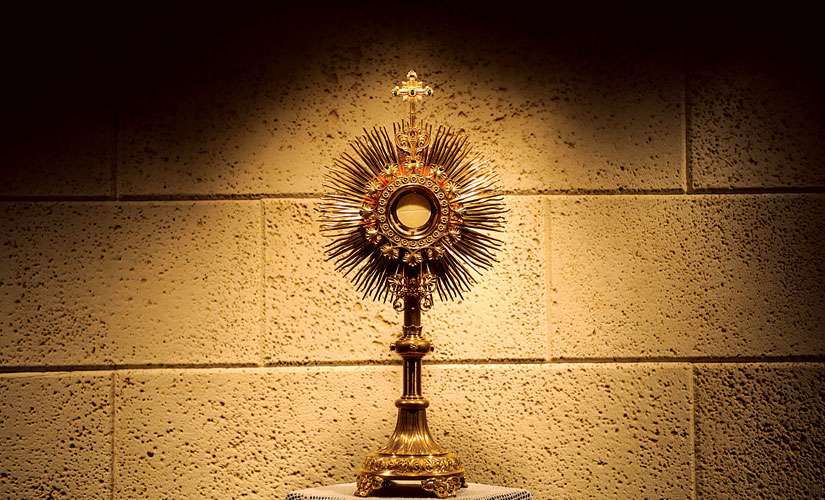In celebration of the feast of Corpus Christi (Body of Christ) on May 29, and prior to the feast of the Sacred Heart of Jesus on June 3, St. Patrick’s parish in Markham, Ont., hosted a Vatican-commissioned photo exhibition of eucharistic miracles from around the world. The parish hall was filled with rows of displays, each one telling a unique story of how a consecrated host physically turned to flesh and blood, often before the eyes of witnesses.
These eucharistic miracles are gifts from God that continue to confirm His real presence in the Blessed Sacrament.
“It’s a dimension of our faith,” said St. Patrick’s pastor Fr. Dominic Barber. “These are miracles where the host becomes more tangibly the Body and Blood of Christ. Through modern-day testing, it has been verified... and even then, we’re still always left with, well what is it? There is still that step of faith that you take.”
The most recent addition to the photo exhibit came from Sokolka, Poland. During Sunday Mass on Oct. 12, 2008, a host was dropped by a priest during communion. Believing it was dirty, he placed the host in the small bowl of water priests use to wash their fingers after communion. Then he placed the bowl in the tabernacle for safe keeping, customary in such cases.
A week later, Sr. Julia Dubowska, the sacristan at the Mass, discovered that host had mostly dissolved, except for a “strange red clot.” The following January, two specialists in pathological anatomy at the Medical University of Bialystok were consulted and, upon extensive examination, found fibres similar to those of a human heart. Despite spending months suspended in water, a piece of cardiac muscle was preserved, with no evidence found of cellular deterioration.
That host is kept in a reliquary, still preserved, in a chapel at St. Anthony of Sokolka parish, where it can be venerated by the public.
The photo exhibition is filled with similar stories. In April, the Vatican approved a miracle that took place in Legnica, Poland, on Christmas Day 2013.
“In many, many instances, these miracles took place where there had been a real waning (of faith) or even doubt,” said Barber. “Like the one in Orvieto (Italy) in 1263, where the priest had difficulty believing that Christ was actually present in the Eucharist and, next thing you know, he’s celebrating the Mass and there’s blood dripping down on the corporal. That miracle actually was the one that prompted Pope Urban IV to institute Corpus Christi Sunday.”
Pope Francis experienced his own eucharistic miracle in 1996 as Auxiliary Bishop Jorge Bergoglio in the Archdiocese of Buenos Aires. As Fr. Alejandro Pezet celebrated Sunday Mass a woman told him she had found a discarded host on a candleholder at the back of the church. Pezet placed it in a container of water and locked it in the tabernacle.
Eight days later, Pezet opened the tabernacle and saw that the host had turned into a bloody substance. He informed Bishop Bergoglio, who took a photograph of the host. For three years, the host remained in the tabernacle and the event was kept secret.
By 1999 the host still had not decomposed, so then Archbishop Bergoglio decided to have it examined. The scientific investigation revealed human DNA in the host that matched DNA found on the Shroud of Turin.
“The miracle thing is one angle, one little example of how God has chosen, and it’s totally God’s choice, to reveal Himself in this way to stir up in us this dimension of faith,” said Barber. “It’s kind of a bit of a ‘wow’ factor. It pokes us a bit and says, ‘oh my gosh, this really is Jesus.’ ”
There are 170 other stories like these in the exhibit, which was assembled by the Vatican International Exhibition. The exhibit was the brainchild of a 15-year-old Italian, Carlo Acutis, who died from leukemia in 2006. His life is currently being investigated as part of a cause for beatification.
In his short life, Acutis moved numerous people with his testimony of faith and devotion to the Eucharist. At the age of 11, he received his First Communion and asked his parents to take him to all the places where the eucharistic miracles occurred. But his health failed and those pilgrimages never happened.
After the teen’s death, it took about two-and-a-half years for his family to organize the exhibition, with the help and support of Cardinal Angelo Comastri from the Vatican Basilica and Msgr. Raffaello Martinelli, who at the time was head of the Catechetical Office of the Congregation for the Doctrine of Faith.
The exhibition has travelled to dozens of countries across five continents. In North America, the Real Presence Eucharistic Education and Adoration Association manages the copyright and distribution of the exhibition from its main office in Lombard, Illinois.
“It’s really for the Church. It’s not for us,” said Carol J. Seydel, who manages the exhibition through TheRealPresence.org. “We’re pure volunteers.”
Carol Johns of Collingwood, Ont., came across the Real Presence web site in February last year. She was struck by the sheer number of stories across history and across the globe, and decided to try to share them with others.
She organized a photo exhibition at her parish, St. Mary’s, last fall and now the exhibit is touring the Archdiocese of Toronto.
“For the people that stop by to read (the displays), if you could see the expression on people’s faces, it’s really amazing,” said Johns. “I have people come back three days in a row and they’re like, ‘I’ve just got to read it all.’ ”
From St. Patrick’s in Markham, the exhibit travels to The Church of the Good Shepherd in Thornhill, Ont., for two weeks starting June 4.


